
This parent guide supports parents in helping their child at home with the 7th grade Science content.
- Subject:
- Science
- Material Type:
- Reference Material
- Vocabulary
- Author:
- Kelly Rawlston
- Letoria Lewis
- Date Added:
- 10/11/2022

This parent guide supports parents in helping their child at home with the 7th grade Science content.

This resource accompanies our Rethink 7th Grade Science course. It includes ideas for use, ways to support exceptional children, ways to extend learning, digital resources and tools, tips for supporting English Language Learners and students with visual and hearing impairments. There are also ideas for offline learning.
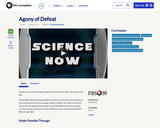
This video clip is meant to serve as a writing or discussion prompt during a unit on forces and motion. This can be used at varied grade levels, with the expectation that student responses would be more complex in higher grade levels.
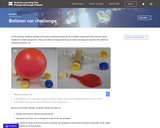
Students design and build a balloon-powered car to better understand the science ideas related to rocket propulsion. They use ideas of mass and force to work out ways to improve the distance traveled by the car.

In this inquiry activity, students solve a 1D motion challenge in groups. Students build their own balloon rocket from the provided materials. They collect data and prepare a position vs. time graph of their data and determine the average velocity of the rocket.
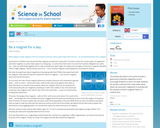
In this lesson, students discuss and demonstrate the internal structure of the magnet through a kinesthetic activity.

Students learn about the physics behind how a bicycle works. In an associated activity, students find out how to bike more efficiently by calculating gear ratios.
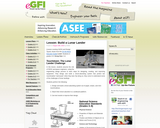
Students will design and manipulate a Lunar Lander model. Students will use scientific inquiry in order to build their design.

In this activity, students are introduced to the concepts of static and kinetic friction and discover how the type of surface involved affects the strength of the frictional force.
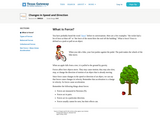
This resource is a compilation of text, videos, and other elements that serves as a multimedia learning experience for students. The resource reviews types of forces and how force affects motion.

Students will design a working trebuchet for maximum accuracy, distance and force using the engineering design process. Students will utilize the measurement formulas to calculate kinetic and potential energy and therefore create a trebuchet for a specific function (ex: hitting a target, knocking down a wall or launching for distance).

In this STEM lesson, students use the NASA Future Flight Design Challenge activity and website to help them learn how NASA engineers develop and test experimental aircraft to solve a specific problem by using the engineering design process. Students will solve an engineering design challenge based on specific criterion and build and design four paper aircraft based on actual NASA experimental aircraft. They will conduct and test their models and gather data of the results based on the design process and a specific challenge. Lastly, students will evaluate the performance of each aircraft based on engineering requirements.
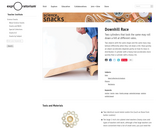
In this activity, students explore how two cylinders that look the same may roll down a hill at different rates.
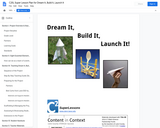
This Super Lesson utilizes Project Based Learning to assist learners with designing, building, and testing flying contraptions as an introduction to Engineering. The goal of this project is to engage students in collaborative team work and to introduce students to the Science and Engineering Practices: Asking Questions and Defining Problems, Planning and Carrying Out Investigations, and Constructing Explanations and Designing Solutions.
We have offered this Super Lesson as an 8-week elective course, developing and strengthening student interest in applied Math and Science topics. It could also be offered within upper elementary or middle school Science and Math courses. In addition, each week’s topic could be used as a stand alone mini-lesson if time is limited. We have worked to include multiple options within this unit to make it accessible to both general education and special education programs, including recommendations for modifications and extensions.
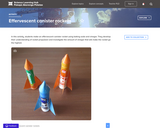
Students make a rocket using baking soda and vinegar. They develop their understanding of rocket propulsion (forces) and investigate the amount of vinegar that will make the rocket go the highest.
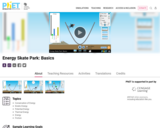
Sample Learning Goals
Explain the Conservation of Mechanical Energy concept using kinetic energy (KE) and gravitational potential energy (PE).
Describe how the Energy Bar and Pie Charts relate to position and speed.
Explain how changing the Skater Mass affects energy.
Explain how changing the Track Friction affects energy.
Predict position or estimate speed from Energy Bar and Pie Charts.
Calculate speed or height at one position from information about a different position.
Calculate KE and PE at one position from information about a different position.
Design a skate park using the concepts of mechanical energy and energy conservation.

In this STEM lesson, students will use a pattern to design and build a robotic rover with cardboard and a balloon. They will investigate the engineering challenges of wheels, speed, and friction while they examine the concept of a prototype in engineering. Students will demonstrate the use of potential and kinetic energy and explain ways the rover can be used in space travel and exploration.
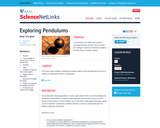
Students explore the relationship between gravitational forces and the mass of objects, the changes in speed and direction of objects, and the distance between objects.
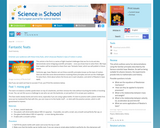
This lesson provides several challenges that students will be able to solve by applying simple physics principles. Solutions are provided.

With this resource, students will use gravity to build a working roller coaster with all the required components.